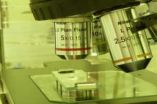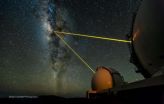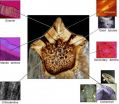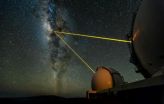(Press-News.org) The tiny pieces of rock – at 50-100 micrometers smaller than a human hair – have been captured from asteroid Itokawa by the Japanese mission Hayabusa. They were carefully unpacked by experts at the University's School of Earth, Atmospheric and Environmental Sciences.
It is the first time samples from an asteroid have been returned to Earth. Only about 70 samples have been released for international analysis – seven of these are being studied at the University.
The Hayabusa mission is part of a continuing effort to understand how asteroids, which are leftovers from the formation of planets like Earth, formed and evolved. It recovered fragments from the 500 metre-long asteroid Itokawa in 2005 and returned them to Earth in 2010.
Itokawa is only the third planetary body from which samples have been returned to Earth, after Apollo/Luna samples from the Moon and 'Stardust' samples from comet Wild 2. All of these have been analysed at The University of Manchester.
Just 11 international scientific teams have been selected to analyse these precious samples. The team, led by Dr Henner Busemann of the University's School of Earth, Atmospheric and Environmental Sciences, includes researchers from Germany, Sweden and Switzerland. It was selected because of two unique devices for analysing the samples – Manchester hosts the most sensitive system in the world for analysing the rare gases xenon and krypton.
The team hopes to find out how rapidly, and by what processes, the asteroid's surface is being changed and whether asteroids like Itokawa could have delivered material to the Earth early in its history.
The work will provide a glimpse into the early history of the Solar System and the formation of the planets more than 4.5 billion years ago.
Dr Busemann said: "Meteorites are samples of asteroids that fall to Earth, and we've learnt a lot by studying them.
"However, these grains are unique because we know which of the millions of asteroids they came from and they haven't been exposed to the Earth's environment. We stand to learn a huge amount about how asteroids formed and evolved".
INFORMATION:
Asteroid fragments could hint at the origin of the solar system
2012-10-05
ELSE PRESS RELEASES FROM THIS DATE:
Everyday evolution
2012-10-05
Take a good look around on your next nature hike. Not only are you experiencing the wonders of the outdoors – you're probably also witnessing evolution in action.
New research from the University of Toronto Mississauga (UTM) on the effect of insects on plant populations has shown that evolution can happen more quickly than was previously assumed, even over a single generation. The study is to be published in the Oct. 5 issue of Science.
"Scientists have long hypothesized that the interaction between plants and insects has led to much of the diversity we see among plants, ...
Abortion rates plummet with free birth control
2012-10-05
Providing birth control to women at no cost substantially reduced unplanned pregnancies and cut abortion rates by 62 percent to 78 percent over the national rate, a new study shows.
The research, by investigators at Washington University School of Medicine in St. Louis, appears online Oct. 4 in Obstetrics & Gynecology.
Among a range of birth control methods offered in the study, most women chose long-acting methods like intrauterine devices (IUDs) or implants, which have lower failure rates than commonly used birth control pills. In the United States, IUDs and implants ...
How ketamine defeats chronic depression
2012-10-05
Many chronically depressed and treatment-resistant patients experience immediate relief from symptoms after taking small amounts of the drug ketamine. For a decade, scientists have been trying to explain the observation first made at Yale University.
Today, current evidence suggests that the pediatric anesthetic helps regenerate synaptic connections between brain cells damaged by stress and depression, according to a review of scientific research written by Yale School of Medicine researchers and published in the Oct. 5 issue of the journal Science.
Ketamine works on ...
UCLA astronomers discover star racing around black hole at center of our galaxy
2012-10-05
UCLA astronomers report the discovery of a remarkable star that orbits the enormous black hole at the center of our Milky Way galaxy in a blistering 11-and-a-half years — the shortest known orbit of any star near this black hole.
The star, known as S0-102, may help astronomers discover whether Albert Einstein was right in his fundamental prediction of how black holes warp space and time, said research co-author Andrea Ghez, leader of the discovery team and a UCLA professor of physics and astronomy who holds the Lauren B. Leichtman and Arthur E. Levine Chair in Astrophysics. ...
Climate sceptics more prominent in UK and US media
2012-10-05
Climate sceptics are being given a more prominent, and sometimes uncontested, voice in UK and US newspapers in contrast to other countries around the world, new research suggests.
The findings have been published today, 5 October, in IOP Publishing's journal Environmental Research Letters, as part of a study looking at how climate scepticism manifested itself in the print media of the US, UK, Brazil, China, India and France during a 3-month period which included 'Climategate' in 2009/10 and a second period which covered the IPCC's Fourth Assessment Report in 2007.
In ...
Maths sheds light on what delays in getting pregnant means for prospects of having a baby
2012-10-05
A new mathematical method can help to predict a couple's chances of becoming pregnant, according to how long they have been trying.
The model may also shed light on how long they should wait before seeking medical help.
For example, the researchers have found that, if the woman is aged 35, after just six months of trying, her chance of getting pregnant in the next cycle is then less than 10 per cent.
The analysis, developed at Warwick Medical School at the University of Warwick and the London School of Economics, uses the number of menstrual cycles over which the ...
Plants adapt their defenses to the local pest community
2012-10-05
Herbivorous insects, such as aphids, damage plants and can substantially reduce yields in agricultural settings; however, they can play a major role in maintaining genetic diversity. Ecologists Tobias Züst and Lindsay Turnbull from the University of Zurich together with colleagues from California and Great Britain demonstrated the importance of variation in herbivore communities using the model plant, Arabidopsis thaliana, also known as wall cress. According to Züst, the work is one of the first experimental confirmations of a forty-year-old theory that herbivorous insects ...
Duck-bill dinosaurs had plant-pulverizing teeth more advanced than horses
2012-10-05
A team of paleontologists and engineers has found that duck-billed dinosaurs had an amazing capacity to chew tough and abrasive plants with grinding teeth more complex than those of cows, horses, and other well-known modern grazers. Their study, which is published today in the journal Science, is the first to recover material properties from fossilized teeth.
Duck-bill dinosaurs, also known as hadrosaurids, were the dominant plant-eaters in what are now Europe, North America, and Asia during the Late Cretaceous about 85 million years ago. With broad jaws bearing as many ...
Medication use higher among overweight, obese kids
2012-10-05
(Edmonton) Overweight children are far more likely to take prescription medications than children of a normal weight—a trend that adds to already higher health-care costs for treating childhood obesity, according to new research from the University of Alberta.
Researchers from the School of Public Health analyzed the medication use of more than 2,000 Canadian children through the 2007 to 2009 Canadian Health Measures Survey. They found that overweight and obese kids aged 12 to 19 years were 59 per cent more likely than their normal-weight peers to take prescription medication.
Co-author ...
TMT will take discoveries of stars orbiting the Milky Way's monster black hole to the next level
2012-10-05
Researchers have discovered a star that whips around the giant black hole at the center of our galaxy in record time, completing an orbit every 11.5 years. The finding, appearing today in the journal Science, points ahead to groundbreaking experiments involving Einstein's general theory of relativity. Those tests will be fully enabled by the Thirty Meter Telescope (TMT), slated to begin observations next decade.
The record-setting star, called S0-102, was detected with the twin 10-meter telescopes at the W.M. Keck Observatory in Hawaii. For the past 17 years, the telescopes ...





